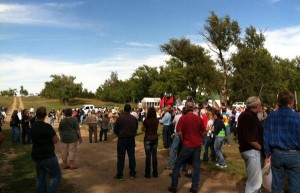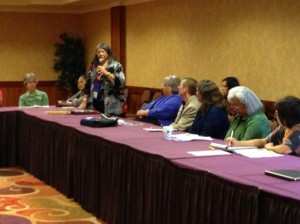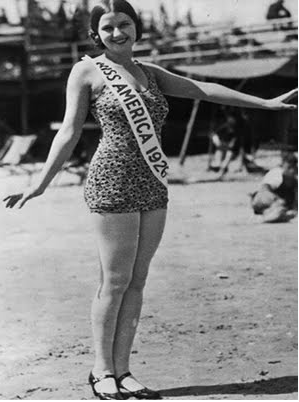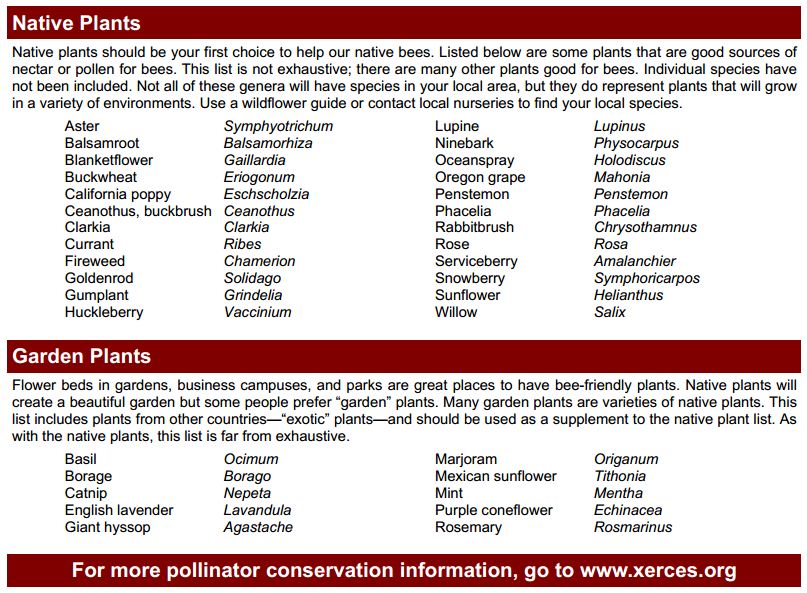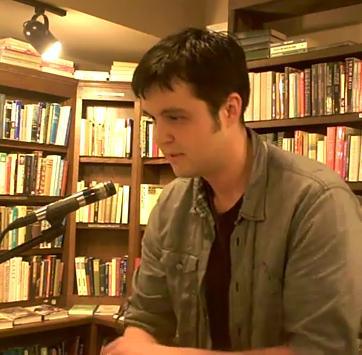Source: Native News Network
CELILO VILLAGE, OREGON – The Department of Justice Wednesday announced the awarding of 192 grants to 110 American Indian tribes, Alaska Native villages, tribal consortia and tribal designated non-profits.
The grants will provide more than $90 million to enhance law enforcement practices and sustain crime prevention and intervention efforts in nine purpose areas including public safety and community policing; justice systems planning; alcohol and substance abuse; corrections and correctional alternatives; violence against women; juvenile justice; and tribal youth programs. The awards are made through the department’s Coordinated Tribal Assistance Solicitation, a single application for tribal-specific grant programs.
Associate Attorney General Tony West and Office of Justice Programs Assistant Attorney General Karol Mason made the announcement during a meeting of northwest tribal leaders with the Attorney General’s Advisory Committee’s Native American Issues Subcommittee (NAIS) in Celilo Village, Oregon.
“These programs take a community based and comprehensive approach to the root causes and consequences of crime, as well as target areas of possible intervention and treatment,”
said Associate Attorney General West.
“The CTAS programs are critical tools to help reverse unacceptably high rates of crime in Indian country, and they are a product of the shared commitment by the Department of Justice and tribal nations to strengthen and sustain healthy communities today and for future generations.”
“The Department of Justice has a responsibility to make sure its resources are not only available but accessible to tribes in a manner that they have defined and envisioned to meet the needs of their communities,”
said Assistant Attorney General Mason.
“As we have shown over the last four years, the Department of Justice takes this responsibility very seriously.”
The department developed CTAS through its Office of Community Oriented Policing, Office of Justice Programs and Office on Violence against Women, and administered the first round of consolidated grants in September 2010.
Over the past four years, it has awarded 989 grants totaling more than $437 million. Information about the consolidated solicitation is available at www.Justice.gov.
A fact sheet on CTAS is available here.
Thirty US Attorneys from districts that include Indian country or one or more federally recognized tribes serve on the NAIS. The NAIS focuses exclusively on Indian country issues, both criminal and civil, and is responsible for making policy recommendations to the Attorney General regarding public safety and legal issues.
Next month, the Justice Department will hold its annual consultation on violence against native women on October 31, in Bismarck, North Dakota. In addition, an Interdepartmental Tribal Justice, Safety and Wellness Session will be held in Bismarck on October 29-30. It will include an important listening session with tribal leaders to obtain their views on the Department grants, as well as valuable training and technical assistance.
Today’s announcement is part of the Justice Department’s ongoing initiative to increase engagement, coordination and action on public safety in tribal communities.
Award List by State
Alaska
Akiachak Native Community
$299,447
Aleut Community of St. Paul Island
$600,000
Bristol Bay Native Association, Inc
$582,054
Iliamna Village Council
$149,561
Kenaitze Indian Tribe
$534,304
Maniilaq Association
$958,252
Native Village of Barrow
$2,940,730
Native Village of Kwinhagak
$149,163
Native Village of Old Harbor
$578,154
Nome Eskimo Community
$697,595
Qagan Tayagungin Tribe
$61,762
Southcentral Foundation
$850,000
Sun’ ‘aq Tribe of Kodiak
$384,657
Traditional Council of Togiak
$442,320
Arizona
Hualapai Detention and Rehabilitation Center
$764,298
Navajo Division of Public Safety
$673,348
Pascua Yaqui Tribe
$605,494
Salt River Pima Maricopa Indian Community
$1,027,981
SanCarlos Apache Tribe
$223,314
Tohono O’odham Nation
$645,725
California
Bishop Indian Tribal Council
$300,000
Cahto Tribe of the Laytonville Rancheria
$299,966
Hoopa Valley Tribe
$1,379,961
Hopland Band of Pomo Indians
$300,000
Round Valley Indian Tribes
$300,000
Shingle Springs Rancheria
$465,906
Two Feathers Native American Family Services
$399,525
Yurok Tribe
$924,999
Colorado
Southern Ute Indian Tribe
$417,554
Florida
Seminole Tribe of Florida
$320,298
Idaho
Coeur D’Alene Tribe
$1,356,626
Nez Perce Tribe
$1,262,805
Kansas
Prairie Band Potawatomi Nation
$777,096
Sac and Fox Nation of Missouri
$222,799
Louisiana
Coushatta Tribe of Louisiana
$725,224
Maine
Aroostook Band of Micmacs
$499,696
Houlton Band of Maliseet Indians
$899,954
Penobscot Nation
$281,099
Michigan
Bay Mills Indian Community
$282,657
Grand Traverse Band of Ottawa and Chippewa Indians
$862,037
Hannahville Indian Community
$305,475
Little Traverse Bay Bands of Odawa Indians
$295,742
Match-E-Be-Nash-She-Wish Band of Pottawatomi Indians
$138,353
Saginaw Chippewa Indian Tribe of Michigan
$1,112,111
Sault Ste. Marie Tribe of Chippewa Indians
$478,356
Minnesota
Fond du Lac Band of Lake Superior Chippewa
$727,056
Leech Lake Band of Ojibwe
$4,994,283
Mille Lacs Band of Ojibwe
$751,379
Red Lake Band of Chippewa Indians
$1,293,218
The Prairie Island Indian Community
$66,411
White Earth Reservation Tribal Council
$278,000
Mississippi
Mississippi Band of Choctaw Indians
$691,000
Montana
Chippewa Cree Tribe
$1,094,574
Confederated Salish and Kootenai Tribes
$721,266
North Carolina
Eastern Band of Cherokee Indians
$891,216
North Dakota
Turtle Mountain Band of Chippewa Indians
$854,084
Nebraska
Omaha Tribe of Nebraska
$803,339
Winnebago Tribe of Nebraska
$1,279,108
New Mexico
Eight Northern Indian Pueblos Council, Inc. PeaceKeepers
$1,300,000
Mescalero Apache Tribe
$450,000
Pueblo of Acoma
$1,324,996
Pueblo of Isleta
$753,858
Pueblo of Jemez
$671,194
Pueblo of Laguna
$401,348
Santa Clara Pueblo
$748,203
Zuni Tribe
$1,416,266
Nevada
Pyramid Lake Paiute Tribe
$1,129,000
Washoe Tribe of Nevada and California
$684,200
New York
Oneida Indian Nation
$223,769
St. Regis Mohawk Tribe
$515,000
Oklahoma
Absentee Shawnee Tribe of Oklahoma
$1,357,873
Apache Tribe of Oklahoma
$765,000
Cherokee Nation
$845,664
Choctaw Nation of Oklahoma
$628,227
Citizen Potawatomi Nation
$1,265,758
Kaw Nation
$1,100,571
Kickapoo Tribe of Oklahoma
$848,234
Miami Tribe of Oklahoma
$296,104
Muscogee (Creek) Nation
$3,734,853
Quapaw Tribe of Oklahoma
$1,049,844
Seminole Nation of Oklahoma
$1,489,068
The Chickasaw Nation
$1,734,022
Tonkawa Tribe of Indians of Oklahoma
$295,342
Wyandotte Nation
$867,061
Oregon
Burns Paiute Tribe
$350,494
Confederated Tribes of Coos, Lower Umpqua and Siuslaw Indians
$298,017
Confederated Tribes of the Grand Ronde Community of Oregon
$695,466
Confederated Tribes of the Umatilla Indian Reservation
$1,150,000
Confederated Tribes of the Warm Springs Reservation
$1,671,142
South Carolina
Catawba Indian Nation
$499,639
South Dakota
Lower Brule Sioux Tribe
$262,977
Sisseton-Wahpeton Oyate of the Lake Traverse Reservation
$156,003
Wiconi Wawokiya Inc
$1,354,000
Washington
Confederated Tribes and Bands of the Yakama Nation
$496,488
ConfederatedTribes of the Chehalis Reservation
$1,125,991
Cowlitz Indian Tribe Total $711,000
Kalispel Tribe of Indians Total $981,540
Port Gamble S’Klallam Tribe
$1,032,932
Puyallup Tribal Council
$2,586,479
Quileute Tribe
$784,446
Spokane Tribe of Indians
$1,060,999
Squaxin Island Tribe
$824,445
Swinomish Indian Tribal Community
$1,049,379
Tulalip Tribes of Washington
$2,068,058
Wisconsin
Great Lakes Indian Fish and Wildlife Commission
$348,095
Lac Courte Oreilles Band of Lake Superior Chippewa
$1,076,105
Lac du Flambeau Band of Lake Superior Chippewa Indians
$591,049
Menominee Indian Tribe of Wisconsin
$269,000
Red Cliff Band of Lake Superior Chippewa
$251,006
St. Croix Chippewa Housing Authority
$571,030
Grand Total
$90,382,567





